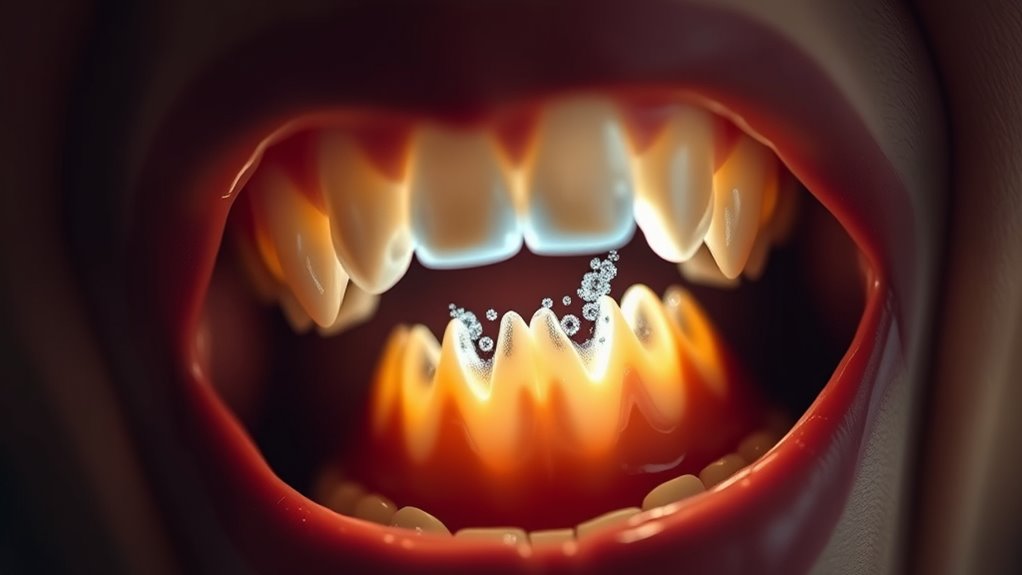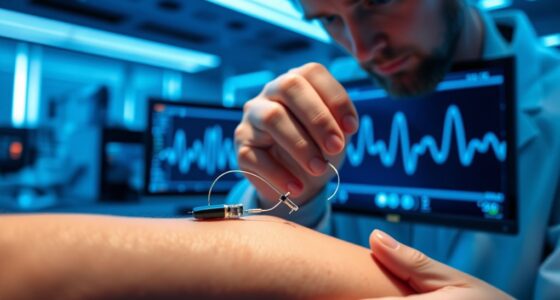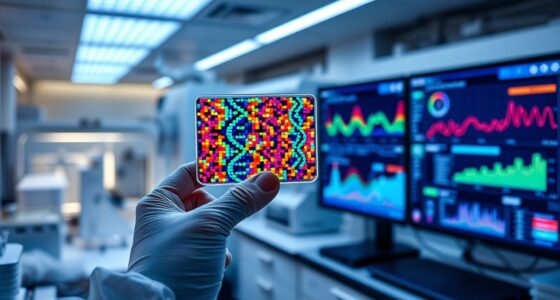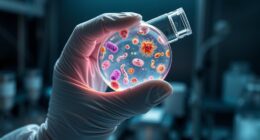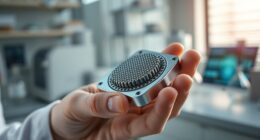Advances in tooth regeneration research suggest that you may soon replace fillings and implants with natural, biological repairs. Scientists are discovering ways to reactivate dormant tooth buds, develop drugs like TRG-035 to stimulate tooth growth, and engineer lab-grown teeth that integrate seamlessly into your jaw. These innovations aim to restore damaged teeth naturally, offering stronger, longer-lasting solutions. If you’re curious about how these breakthroughs could transform your dental health, there’s more to explore below.
Key Takeaways
- Neutralizing USAG-1 can reactivate dormant tooth buds, enabling natural tooth regeneration in adults.
- Drugs like TRG-035 are in clinical trials to promote biological tooth growth, potentially replacing artificial fillings and implants.
- Lab-grown teeth with self-repair capabilities are being developed to integrate seamlessly and reduce rejection risks.
- Enamel regeneration technologies, such as specialized gels, aim to repair teeth naturally, reducing the need for fillings.
- Advances in tissue engineering suggest a future where natural tooth regeneration could eliminate the need for traditional dental restorations.
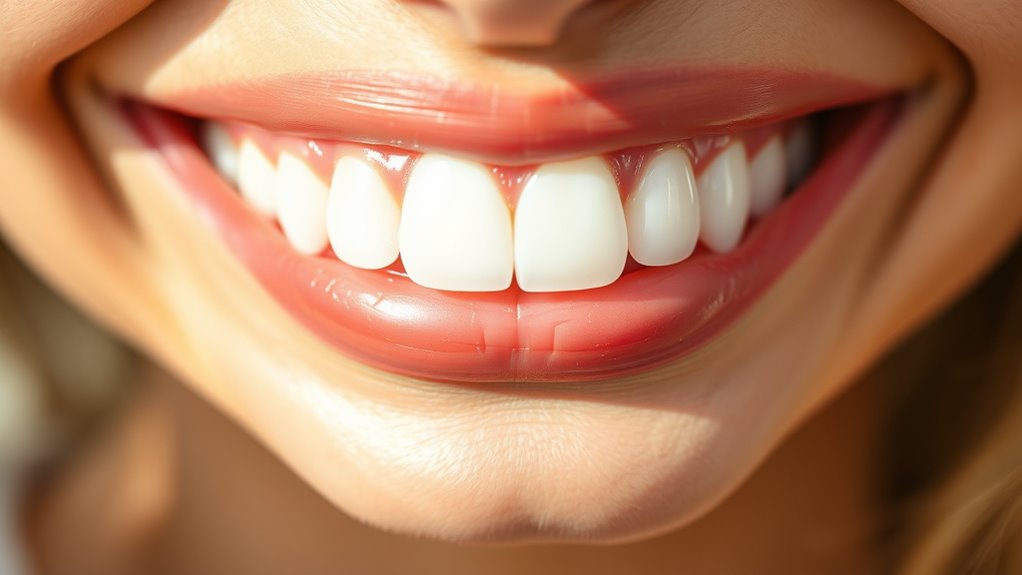
Have you ever wondered if losing teeth could someday be a thing of the past? Recent advances in dental science suggest that might soon be possible. Humans naturally grow two sets of teeth—baby teeth followed by permanent ones—but scientists have uncovered dormant tooth buds that could allow a third set to grow. These buds are typically suppressed by a protein called USAG-1, which acts like a natural stop sign, preventing further tooth development. When USAG-1 is neutralized, these dormant buds can reactivate, opening the door to biologically based tooth regeneration rather than relying solely on traditional dental treatments like fillings, crowns, or implants. Moreover, the discovery of dormant tooth buds confirms the existence of dormant regenerative potential in adult humans, indicating that the body may be capable of producing new teeth under the right conditions. A promising development is the creation of a drug called TRG-035, designed specifically to neutralize USAG-1. Developed by Dr. Katsu Takahashi and researchers at Kyoto University, TRG-035 is administered intravenously and has already shown success in animal trials. Tests on mice and ferrets resulted in the formation of fully functional, natural teeth without adverse reactions. Now, clinical trials are underway to determine if TRG-035 can safely stimulate tooth growth in humans. If these trials are successful, it could mean that instead of filling cavities or fitting artificial implants, you’d be able to grow back your natural teeth. This approach offers a more biological, natural solution to tooth loss and could revolutionize dental care. Beyond drug development, scientists are exploring lab-grown teeth as another future solution. These teeth can be integrated into the jawbone just like natural teeth and are expected to be stronger, longer-lasting, and less prone to rejection. They might also possess self-repair abilities similar to natural teeth, reducing the need for replacements over time. Institutions like King’s College London have been researching this technology for over a decade, aiming to create biologically compatible teeth that could eventually replace artificial restorations. This biological approach could considerably lower complications associated with traditional dentures and implants. In addition, researchers have made strides in regenerating enamel—the hardest tissue in your teeth—using special gels. These gels can create a new enamel layer within just 48 hours that closely resembles natural enamel in structure and strength. This innovation could eventually replace fillings, offering a durable, natural repair that’s both affordable and scalable for widespread use. Though challenges remain—particularly in coordinating the complex tissues needed for a whole tooth—the progress so far is promising. The next few years could see a shift toward natural tooth regeneration, making traditional restorations obsolete and transforming how we approach dental health. Additionally, ongoing research into tissue engineering approaches continues to advance the potential for complete tooth regeneration in humans.
Frequently Asked Questions
How Long Does the Tooth Regeneration Process Take?
When you ask how long tooth regeneration takes, it depends on several factors. Soft tissue healing around the socket can take about 2 to 4 weeks, while new bone formation may take 3 to 4 months. Complete healing and remodeling can extend to 6 to 9 months or more, especially with complex grafts. Your individual health, care, and the procedure’s complexity all influence the overall timeline.
Are There Any Risks or Side Effects Involved?
You should be aware that regenerative dental treatments carry certain risks and side effects. You might experience inflammation, swelling, or discomfort during healing, which usually resolve within a few weeks. There’s also a chance of infection, immune reactions, or unintended tissue growth outside the targeted area. Additionally, the long-term safety of these treatments isn’t fully established yet, so it is crucial to follow your dentist’s advice and attend regular check-ups.
Is Tooth Regeneration Suitable for All Ages?
You wonder if tooth regeneration works for everyone. Right now, it’s more suitable for younger people with developing teeth because their stem cells are more active. For older adults, especially those with complete tooth loss, regeneration is challenging due to reduced cell activity and tissue changes. While research advances, current options like implants and dentures remain standard for adults, and full regeneration across all ages isn’t yet a reality.
How Much Does Tooth Regeneration Treatment Cost?
Think of tooth regeneration as planting a new seed for your smile. The cost varies, depending on the method you choose. Stem cell therapies can range from $5,000 to $10,000, while injection treatments like PRP usually cost between $500 and $2,000 per session. Keep in mind, multiple sessions or advanced procedures can increase the overall price. Your location and provider also influence the final cost, so shop around for options.
Will Regenerated Teeth Be as Strong as Natural Teeth?
You wonder if regenerated teeth will match natural teeth in strength. Currently, it’s a challenge because regenerating enamel and dentin with the same durability is complex. Scientists are making progress by developing bioengineered materials that aim to replicate natural structures. While future regenerative teeth could potentially be just as strong or even better, they still need to overcome hurdles like durability, integration, and sensory feedback before fully matching natural teeth.
Conclusion
Imagine a future where your teeth heal themselves like a garden blooming anew, no more fillings or implants needed. This revolutionary science promises to turn that dream into reality, giving you a natural, pain-free smile that shines brighter than ever. As researchers unseal nature’s secrets, your teeth could become resilient warriors, fighting decay and restoring themselves. Embrace this new dawn—your smile’s renaissance is just around the corner, ready to blossom like spring after a long winter.

